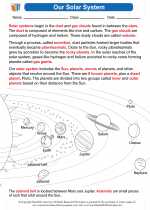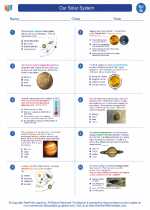Our Solar System -> states of matter
States of Matter
The states of matter are the distinct forms that different phases of matter take on. The four primary states of matter are solid, liquid, gas, and plasma. Understanding the properties of each state of matter is crucial to understanding the behavior of substances in various conditions.
Solids
Solids have a definite shape and volume. The particles in a solid are tightly packed together and vibrate in place. They have a fixed arrangement and are not easily compressed. Examples of solids include ice, wood, and metal.
Liquids
Liquids have a definite volume but take the shape of their container. The particles in a liquid are close together but can move past each other. Liquids are not easily compressed and have a free surface. Examples of liquids include water, oil, and milk.
Gases
Gases have neither a definite shape nor a definite volume. The particles in a gas are far apart and move freely, colliding with each other and the walls of their container. Gases are easily compressed and expand to fill the available space. Examples of gases include air, oxygen, and carbon dioxide.
Plasma
Plasma is the most common state of matter in the universe. It is a highly ionized gas that consists of positively and negatively charged particles. Plasma does not have a definite shape or volume and is influenced by electric and magnetic fields. Examples of plasmas include lightning, stars, and the sun.
Changes of State
Matter can change from one state to another through processes such as melting, freezing, evaporation, condensation, sublimation, and deposition. These changes are driven by the addition or removal of heat energy.
Study Guide
- Define the four primary states of matter.
- Describe the properties of solids, liquids, and gases.
- Explain the concept of plasma and provide examples.
- Identify the different changes of state and the associated processes.
- Discuss the role of heat energy in changing the states of matter.
[States Of Matter] Related Worksheets and Study Guides:
.◂Science Worksheets and Study Guides Seventh Grade. Our Solar System

 Activity Lesson
Activity Lesson
 Activity Lesson
Activity Lesson
 Worksheet/Answer key
Worksheet/Answer key
 Worksheet/Answer key
Worksheet/Answer key
 Worksheet/Answer key
Worksheet/Answer key
 Worksheet/Answer key
Worksheet/Answer key
 Vocabulary/Answer key
Vocabulary/Answer key
 Vocabulary/Answer key
Vocabulary/Answer key
 Vocabulary/Answer key
Vocabulary/Answer key
